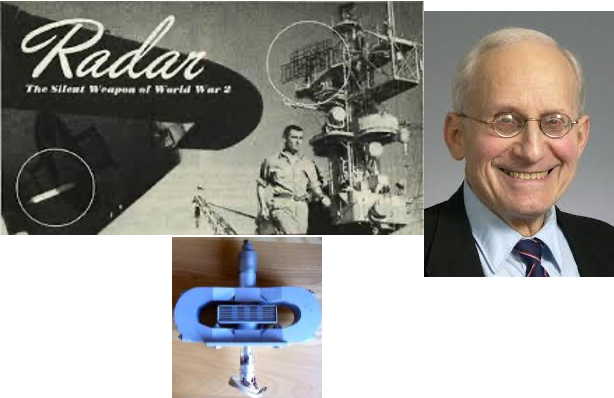How Radar Helped Win World War II -Distinguished Lecturer Eli Brookner
AESS Chapter Meeting. Virtual Meeting Registration open to all IEEE chapters and sections to co-host and serve their local membership and the public. Registration is collected through Boston, watch out for time zone as 6:30 eastern start time is 3:30 pacific.

Talk for the general public of all ages and technical levels.
Dr. Brookner will provide an easy to understand explanation of how radar works. Radar was in its infancy at the start of World War II. The British were using radar effectively along their coastline with a network of antennas on 300-foot-tall towers to warn of approaching enemy aircraft and missiles but they needed an invention that would allow radars to be small enough to fit on ships and aircraft. They invented the cavity magnetron and looked to American manufacturing know-how and resources for rapid mass production. They were turned down by all the major US firms, but a small Boston newcomer, Raytheon Company, responded with a solution. The once small company ended up making 85% of all magnetrons used by the allies in the war; this changed the course of the war. By the end of World War II, Raytheon’s shipborne radars were on all allied ships military and civilian. Radar can see at night, through clouds, in and fog. Radar can be used to land aircraft in zero visibility. Radar can be used to identify targets to prevent fratricide, deploy forces optimally, for navigation, for collision avoidance.
Eli Brookner, global radar authority, worked at Raytheon Company from 1962 to 2014. Dr. Brookner will show just how dramatically the use of radar on aircraft and ships helped to destroy enemy aircraft, ships, missiles and submarines. How the use of miniature radars on the tops of artillery shells immensely increased their effectiveness against aircraft, missiles, infantry men and their equipment. These miniature TOP SECRET radars, called proximity fuzes, used miniature glass tubes which had to withstand 20,000 g when blasted from the artillery guns. Raytheon was one of the suppliers of these tubes. 22,000,000 proximity fuzes with 140,000,000 tubes were produced during WW II.
Date and Time
Location
Hosts
Registration
-
 Add Event to Calendar
Add Event to Calendar
- (Virtual Meeting)
- Connection information will be supplied to all preregistered.
- San Diego, California
- United States 92130
- Contact Event Host
-
This meeting will be offered virtually -- IEEE connection information will be provided to all preregistered attendees.
- Co-sponsored by San Diego Chapter of the Aerospace Electronic Systems Society with the IEEE Boston Chapter
Speakers
 Dr. Eli Brookner, Distinguished Lecturer of RMIT University (Melbourne)
Dr. Eli Brookner, Distinguished Lecturer of RMIT University (Melbourne)
Eli Brookner is a global radar authority known for his contributions to airborne, intelligence, space, air-traffic control and defense mission systems. Among his accomplishments is his leadership in designing advanced airport surveillance radars, making air travel safer.
A principal engineering fellow at Raytheon Company’s Integrated Defense Systems, Sudbury, Massachusetts, Dr. Brookner has played a key role in many major radar and phased-array radar systems developed during the past 40 years. His teaching and lecturing have inspired and educated several generations of radar engineers worldwide, over 10,000 have attended his lectures.
At Raytheon, he has been a leader or advisor to over 20 major radar programs for civil and defense applications. During these programs he demonstrated exceptional technical leadership, devising less-expensive and better-performing alternatives to products on the market or on the drawing board. From 1972 to 1989, he was the technical lead on virtually all major U.S. Air Force and U.S. Navy space-based radar studies.
Address:Boston, Massachusetts, United States
Agenda
3:55 PM PACIFIC (6:55 Eastern) Joint Meeting - Registration is collected through Boston, watch out for time zone
4:00 Speaker
Pre-registration required. This meeting will be available via webinar and your contact details are necessary to provide connection information.

